Victoria University Report: Planning, Organizing, and Leading Analysis
VerifiedAdded on 2020/03/16
|10
|1833
|51
Report
AI Summary
This report examines the leadership practices at Victoria University, focusing on the key management functions of planning, organizing, and leading. The report begins by defining and analyzing the theory and practical application of planning, including the importance of strategic planning, business plans, and the role of managers in setting goals and allocating resources. It then explores the organizing function, detailing how Victoria University structures its departments and allocates responsibilities to ensure effective implementation of plans, including the importance of clear communication and organizational structure. The report also analyzes the leadership styles employed at Victoria University, highlighting the use of democratic and participatory leadership to motivate employees and address challenges. The findings are based on interviews and observations, providing insights into the university's approach to leadership and management. The report concludes with recommendations for improving planning, incorporating innovation, and addressing employee motivation, offering a comprehensive overview of leadership dynamics within the university context.
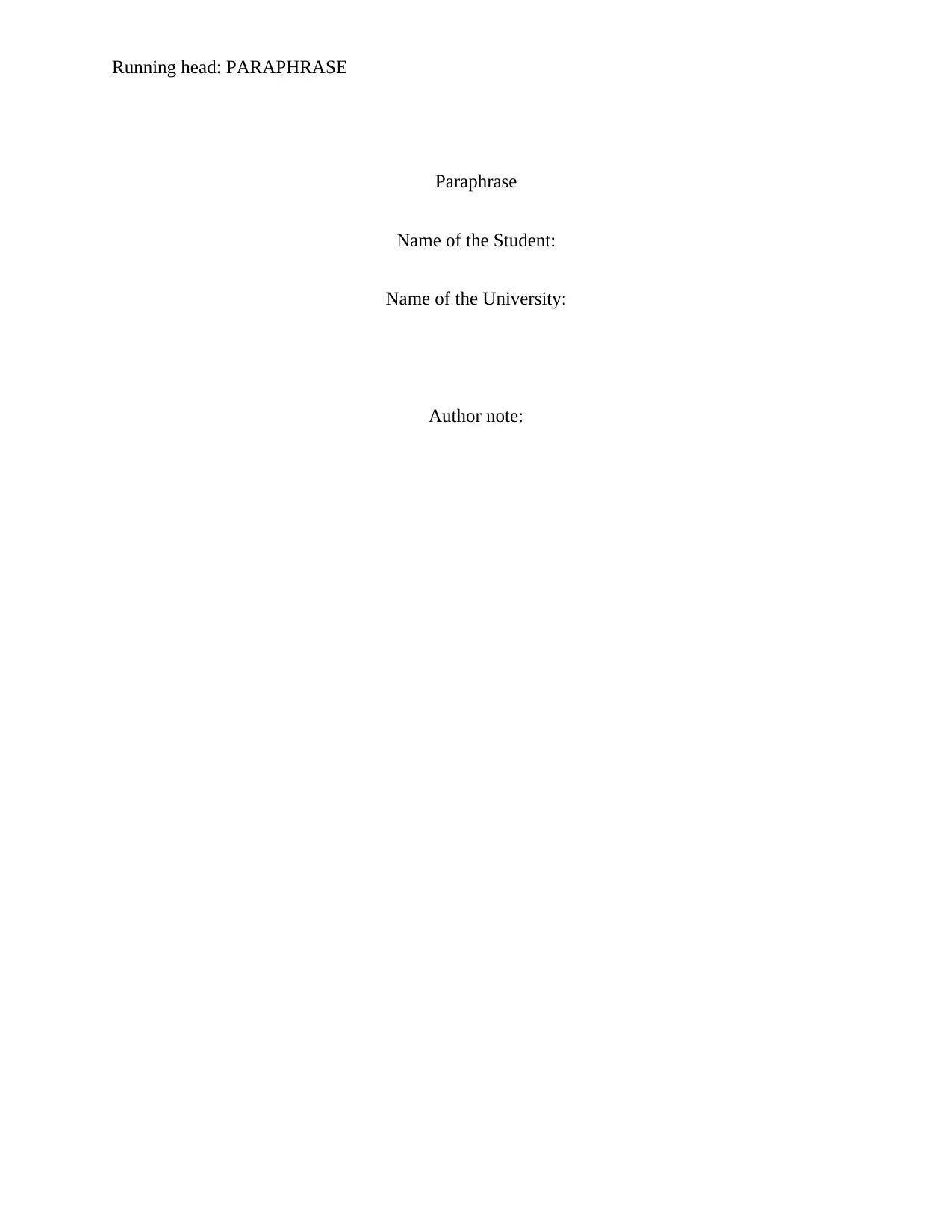
Running head: PARAPHRASE
Paraphrase
Name of the Student:
Name of the University:
Author note:
Paraphrase
Name of the Student:
Name of the University:
Author note:
Secure Best Marks with AI Grader
Need help grading? Try our AI Grader for instant feedback on your assignments.
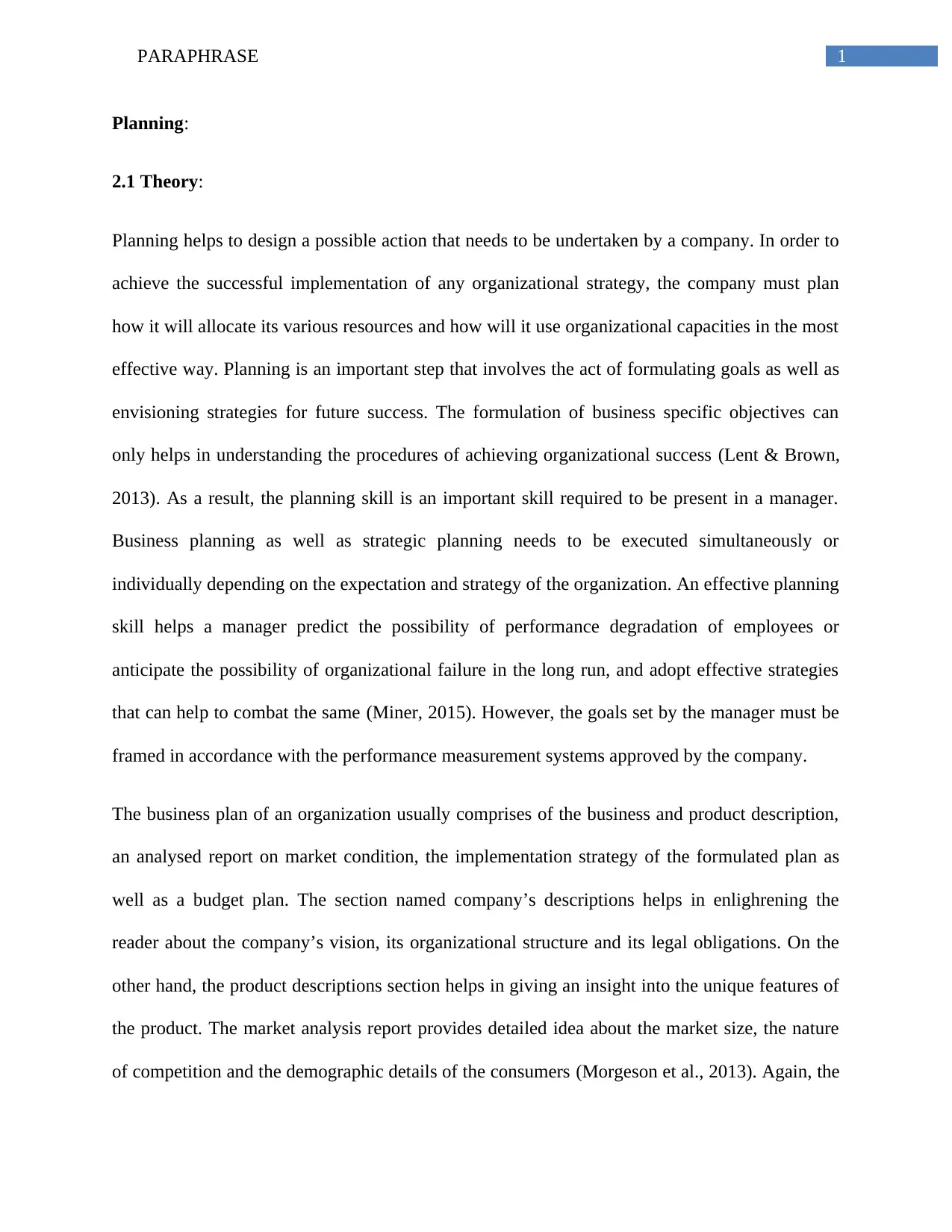
1PARAPHRASE
Planning:
2.1 Theory:
Planning helps to design a possible action that needs to be undertaken by a company. In order to
achieve the successful implementation of any organizational strategy, the company must plan
how it will allocate its various resources and how will it use organizational capacities in the most
effective way. Planning is an important step that involves the act of formulating goals as well as
envisioning strategies for future success. The formulation of business specific objectives can
only helps in understanding the procedures of achieving organizational success (Lent & Brown,
2013). As a result, the planning skill is an important skill required to be present in a manager.
Business planning as well as strategic planning needs to be executed simultaneously or
individually depending on the expectation and strategy of the organization. An effective planning
skill helps a manager predict the possibility of performance degradation of employees or
anticipate the possibility of organizational failure in the long run, and adopt effective strategies
that can help to combat the same (Miner, 2015). However, the goals set by the manager must be
framed in accordance with the performance measurement systems approved by the company.
The business plan of an organization usually comprises of the business and product description,
an analysed report on market condition, the implementation strategy of the formulated plan as
well as a budget plan. The section named company’s descriptions helps in enlighrening the
reader about the company’s vision, its organizational structure and its legal obligations. On the
other hand, the product descriptions section helps in giving an insight into the unique features of
the product. The market analysis report provides detailed idea about the market size, the nature
of competition and the demographic details of the consumers (Morgeson et al., 2013). Again, the
Planning:
2.1 Theory:
Planning helps to design a possible action that needs to be undertaken by a company. In order to
achieve the successful implementation of any organizational strategy, the company must plan
how it will allocate its various resources and how will it use organizational capacities in the most
effective way. Planning is an important step that involves the act of formulating goals as well as
envisioning strategies for future success. The formulation of business specific objectives can
only helps in understanding the procedures of achieving organizational success (Lent & Brown,
2013). As a result, the planning skill is an important skill required to be present in a manager.
Business planning as well as strategic planning needs to be executed simultaneously or
individually depending on the expectation and strategy of the organization. An effective planning
skill helps a manager predict the possibility of performance degradation of employees or
anticipate the possibility of organizational failure in the long run, and adopt effective strategies
that can help to combat the same (Miner, 2015). However, the goals set by the manager must be
framed in accordance with the performance measurement systems approved by the company.
The business plan of an organization usually comprises of the business and product description,
an analysed report on market condition, the implementation strategy of the formulated plan as
well as a budget plan. The section named company’s descriptions helps in enlighrening the
reader about the company’s vision, its organizational structure and its legal obligations. On the
other hand, the product descriptions section helps in giving an insight into the unique features of
the product. The market analysis report provides detailed idea about the market size, the nature
of competition and the demographic details of the consumers (Morgeson et al., 2013). Again, the
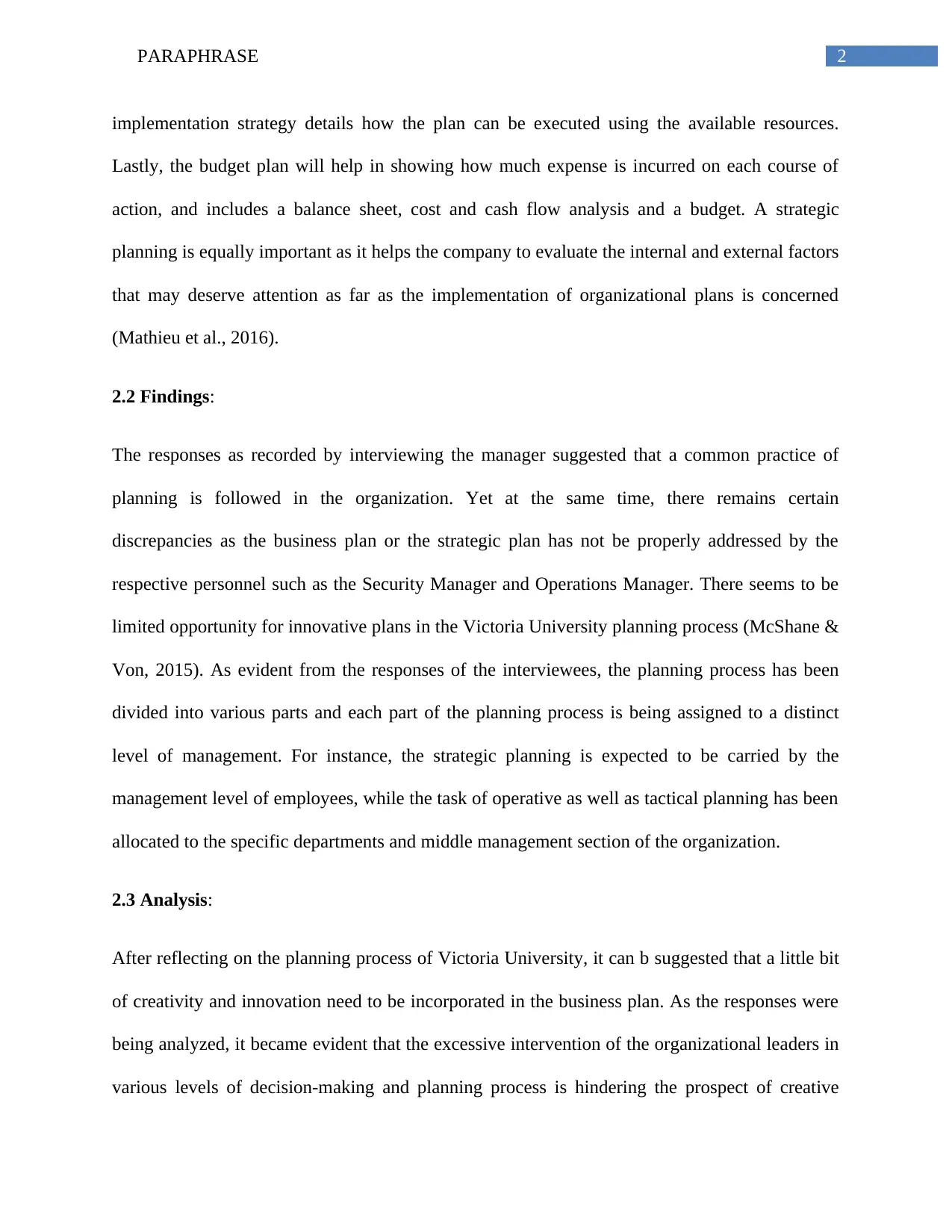
2PARAPHRASE
implementation strategy details how the plan can be executed using the available resources.
Lastly, the budget plan will help in showing how much expense is incurred on each course of
action, and includes a balance sheet, cost and cash flow analysis and a budget. A strategic
planning is equally important as it helps the company to evaluate the internal and external factors
that may deserve attention as far as the implementation of organizational plans is concerned
(Mathieu et al., 2016).
2.2 Findings:
The responses as recorded by interviewing the manager suggested that a common practice of
planning is followed in the organization. Yet at the same time, there remains certain
discrepancies as the business plan or the strategic plan has not be properly addressed by the
respective personnel such as the Security Manager and Operations Manager. There seems to be
limited opportunity for innovative plans in the Victoria University planning process (McShane &
Von, 2015). As evident from the responses of the interviewees, the planning process has been
divided into various parts and each part of the planning process is being assigned to a distinct
level of management. For instance, the strategic planning is expected to be carried by the
management level of employees, while the task of operative as well as tactical planning has been
allocated to the specific departments and middle management section of the organization.
2.3 Analysis:
After reflecting on the planning process of Victoria University, it can b suggested that a little bit
of creativity and innovation need to be incorporated in the business plan. As the responses were
being analyzed, it became evident that the excessive intervention of the organizational leaders in
various levels of decision-making and planning process is hindering the prospect of creative
implementation strategy details how the plan can be executed using the available resources.
Lastly, the budget plan will help in showing how much expense is incurred on each course of
action, and includes a balance sheet, cost and cash flow analysis and a budget. A strategic
planning is equally important as it helps the company to evaluate the internal and external factors
that may deserve attention as far as the implementation of organizational plans is concerned
(Mathieu et al., 2016).
2.2 Findings:
The responses as recorded by interviewing the manager suggested that a common practice of
planning is followed in the organization. Yet at the same time, there remains certain
discrepancies as the business plan or the strategic plan has not be properly addressed by the
respective personnel such as the Security Manager and Operations Manager. There seems to be
limited opportunity for innovative plans in the Victoria University planning process (McShane &
Von, 2015). As evident from the responses of the interviewees, the planning process has been
divided into various parts and each part of the planning process is being assigned to a distinct
level of management. For instance, the strategic planning is expected to be carried by the
management level of employees, while the task of operative as well as tactical planning has been
allocated to the specific departments and middle management section of the organization.
2.3 Analysis:
After reflecting on the planning process of Victoria University, it can b suggested that a little bit
of creativity and innovation need to be incorporated in the business plan. As the responses were
being analyzed, it became evident that the excessive intervention of the organizational leaders in
various levels of decision-making and planning process is hindering the prospect of creative
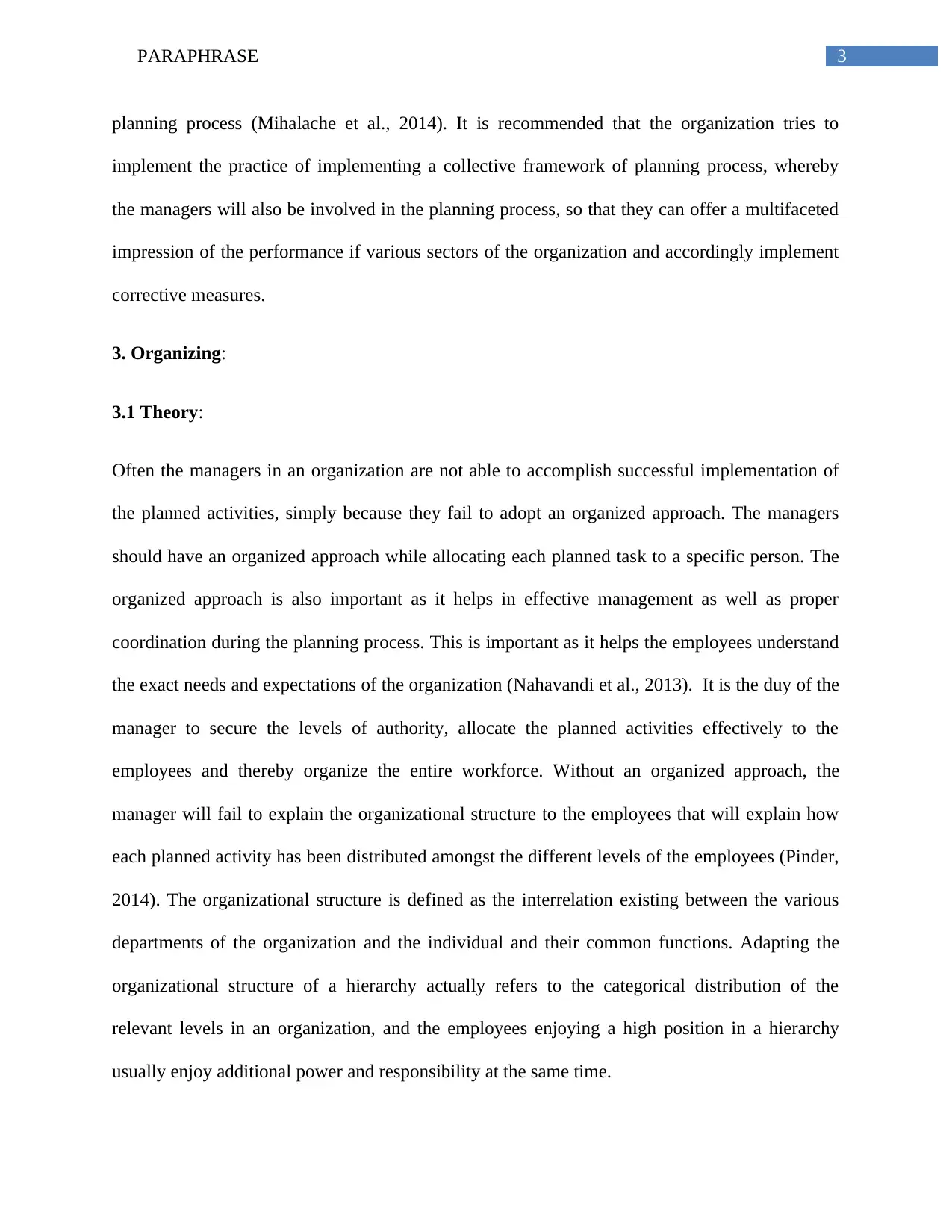
3PARAPHRASE
planning process (Mihalache et al., 2014). It is recommended that the organization tries to
implement the practice of implementing a collective framework of planning process, whereby
the managers will also be involved in the planning process, so that they can offer a multifaceted
impression of the performance if various sectors of the organization and accordingly implement
corrective measures.
3. Organizing:
3.1 Theory:
Often the managers in an organization are not able to accomplish successful implementation of
the planned activities, simply because they fail to adopt an organized approach. The managers
should have an organized approach while allocating each planned task to a specific person. The
organized approach is also important as it helps in effective management as well as proper
coordination during the planning process. This is important as it helps the employees understand
the exact needs and expectations of the organization (Nahavandi et al., 2013). It is the duy of the
manager to secure the levels of authority, allocate the planned activities effectively to the
employees and thereby organize the entire workforce. Without an organized approach, the
manager will fail to explain the organizational structure to the employees that will explain how
each planned activity has been distributed amongst the different levels of the employees (Pinder,
2014). The organizational structure is defined as the interrelation existing between the various
departments of the organization and the individual and their common functions. Adapting the
organizational structure of a hierarchy actually refers to the categorical distribution of the
relevant levels in an organization, and the employees enjoying a high position in a hierarchy
usually enjoy additional power and responsibility at the same time.
planning process (Mihalache et al., 2014). It is recommended that the organization tries to
implement the practice of implementing a collective framework of planning process, whereby
the managers will also be involved in the planning process, so that they can offer a multifaceted
impression of the performance if various sectors of the organization and accordingly implement
corrective measures.
3. Organizing:
3.1 Theory:
Often the managers in an organization are not able to accomplish successful implementation of
the planned activities, simply because they fail to adopt an organized approach. The managers
should have an organized approach while allocating each planned task to a specific person. The
organized approach is also important as it helps in effective management as well as proper
coordination during the planning process. This is important as it helps the employees understand
the exact needs and expectations of the organization (Nahavandi et al., 2013). It is the duy of the
manager to secure the levels of authority, allocate the planned activities effectively to the
employees and thereby organize the entire workforce. Without an organized approach, the
manager will fail to explain the organizational structure to the employees that will explain how
each planned activity has been distributed amongst the different levels of the employees (Pinder,
2014). The organizational structure is defined as the interrelation existing between the various
departments of the organization and the individual and their common functions. Adapting the
organizational structure of a hierarchy actually refers to the categorical distribution of the
relevant levels in an organization, and the employees enjoying a high position in a hierarchy
usually enjoy additional power and responsibility at the same time.
Secure Best Marks with AI Grader
Need help grading? Try our AI Grader for instant feedback on your assignments.
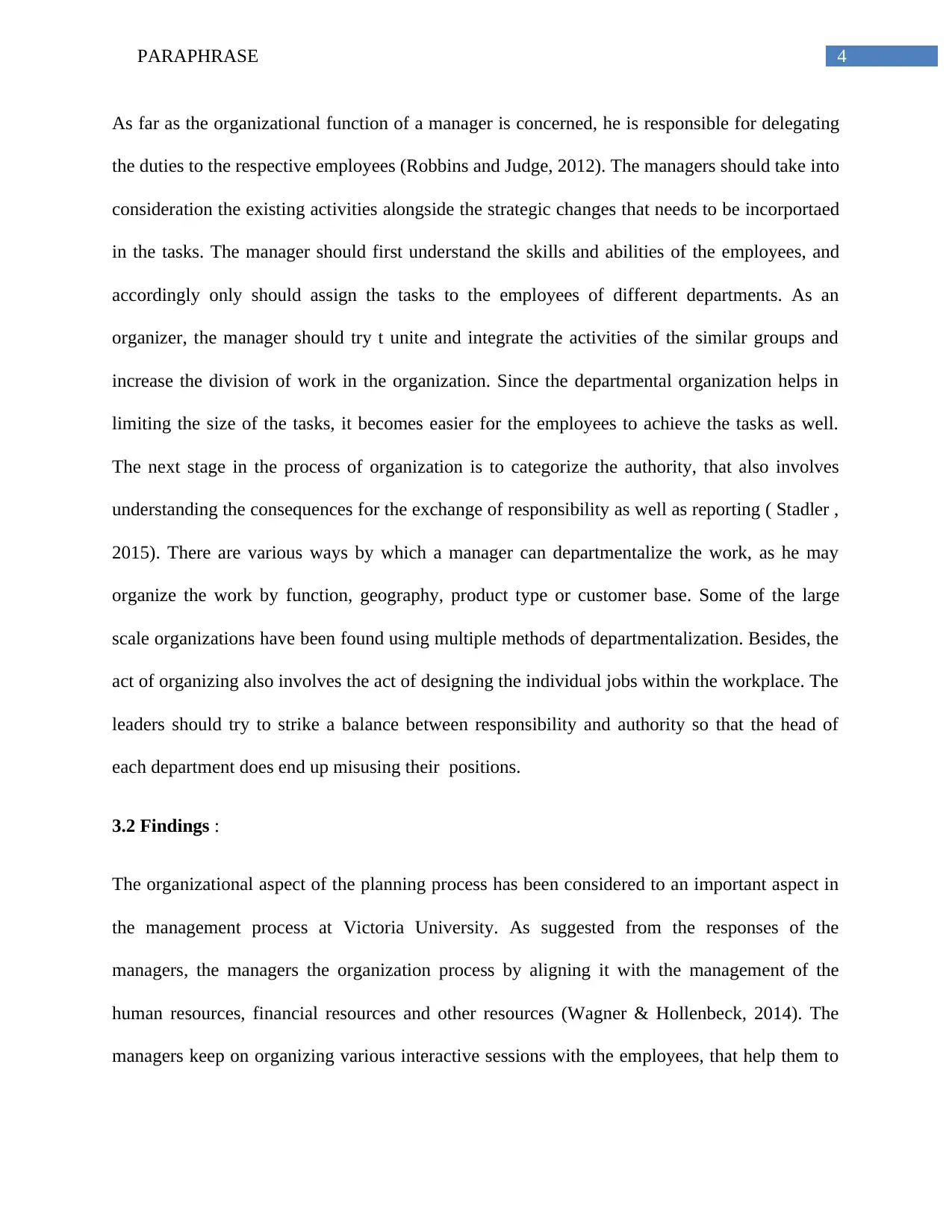
4PARAPHRASE
As far as the organizational function of a manager is concerned, he is responsible for delegating
the duties to the respective employees (Robbins and Judge, 2012). The managers should take into
consideration the existing activities alongside the strategic changes that needs to be incorportaed
in the tasks. The manager should first understand the skills and abilities of the employees, and
accordingly only should assign the tasks to the employees of different departments. As an
organizer, the manager should try t unite and integrate the activities of the similar groups and
increase the division of work in the organization. Since the departmental organization helps in
limiting the size of the tasks, it becomes easier for the employees to achieve the tasks as well.
The next stage in the process of organization is to categorize the authority, that also involves
understanding the consequences for the exchange of responsibility as well as reporting ( Stadler ,
2015). There are various ways by which a manager can departmentalize the work, as he may
organize the work by function, geography, product type or customer base. Some of the large
scale organizations have been found using multiple methods of departmentalization. Besides, the
act of organizing also involves the act of designing the individual jobs within the workplace. The
leaders should try to strike a balance between responsibility and authority so that the head of
each department does end up misusing their positions.
3.2 Findings :
The organizational aspect of the planning process has been considered to an important aspect in
the management process at Victoria University. As suggested from the responses of the
managers, the managers the organization process by aligning it with the management of the
human resources, financial resources and other resources (Wagner & Hollenbeck, 2014). The
managers keep on organizing various interactive sessions with the employees, that help them to
As far as the organizational function of a manager is concerned, he is responsible for delegating
the duties to the respective employees (Robbins and Judge, 2012). The managers should take into
consideration the existing activities alongside the strategic changes that needs to be incorportaed
in the tasks. The manager should first understand the skills and abilities of the employees, and
accordingly only should assign the tasks to the employees of different departments. As an
organizer, the manager should try t unite and integrate the activities of the similar groups and
increase the division of work in the organization. Since the departmental organization helps in
limiting the size of the tasks, it becomes easier for the employees to achieve the tasks as well.
The next stage in the process of organization is to categorize the authority, that also involves
understanding the consequences for the exchange of responsibility as well as reporting ( Stadler ,
2015). There are various ways by which a manager can departmentalize the work, as he may
organize the work by function, geography, product type or customer base. Some of the large
scale organizations have been found using multiple methods of departmentalization. Besides, the
act of organizing also involves the act of designing the individual jobs within the workplace. The
leaders should try to strike a balance between responsibility and authority so that the head of
each department does end up misusing their positions.
3.2 Findings :
The organizational aspect of the planning process has been considered to an important aspect in
the management process at Victoria University. As suggested from the responses of the
managers, the managers the organization process by aligning it with the management of the
human resources, financial resources and other resources (Wagner & Hollenbeck, 2014). The
managers keep on organizing various interactive sessions with the employees, that help them to
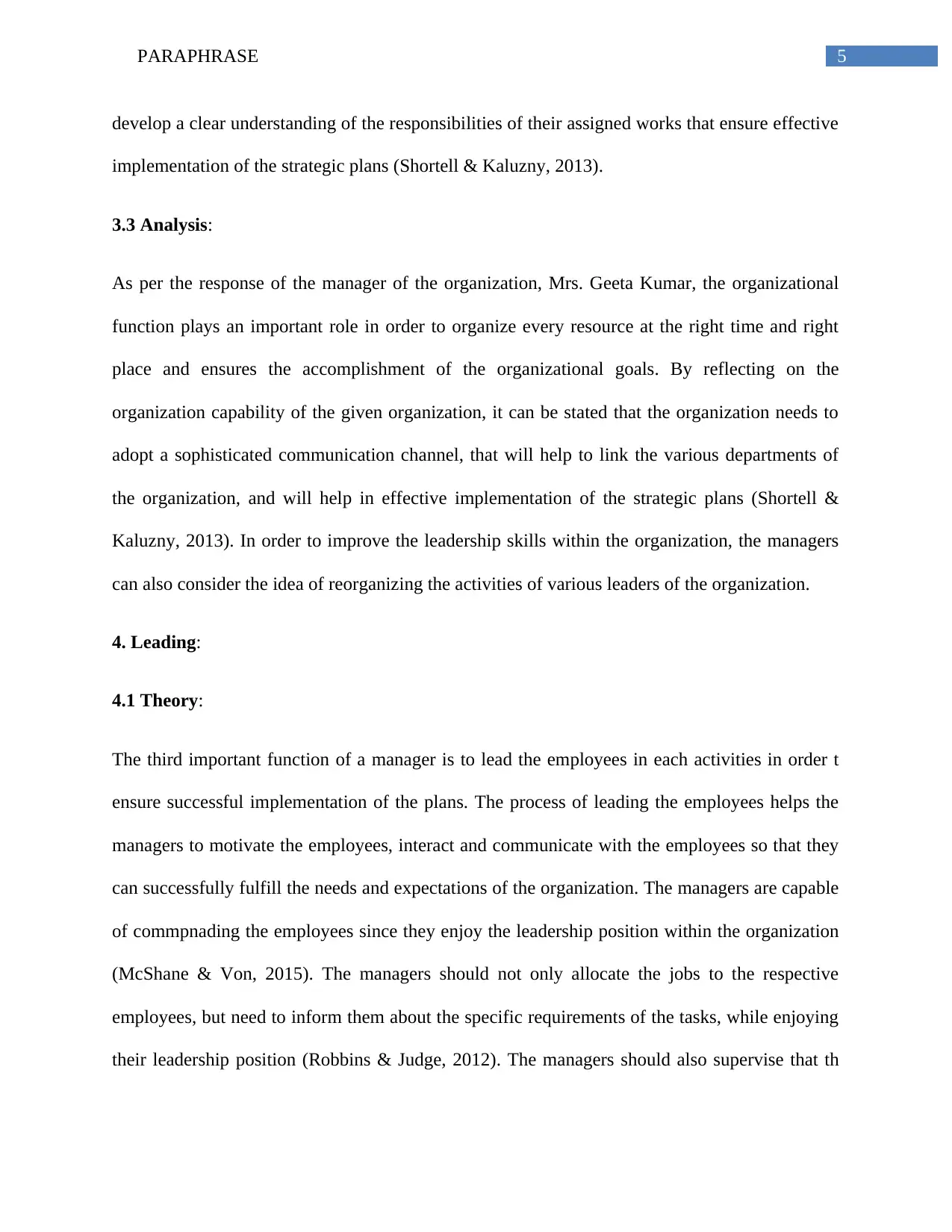
5PARAPHRASE
develop a clear understanding of the responsibilities of their assigned works that ensure effective
implementation of the strategic plans (Shortell & Kaluzny, 2013).
3.3 Analysis:
As per the response of the manager of the organization, Mrs. Geeta Kumar, the organizational
function plays an important role in order to organize every resource at the right time and right
place and ensures the accomplishment of the organizational goals. By reflecting on the
organization capability of the given organization, it can be stated that the organization needs to
adopt a sophisticated communication channel, that will help to link the various departments of
the organization, and will help in effective implementation of the strategic plans (Shortell &
Kaluzny, 2013). In order to improve the leadership skills within the organization, the managers
can also consider the idea of reorganizing the activities of various leaders of the organization.
4. Leading:
4.1 Theory:
The third important function of a manager is to lead the employees in each activities in order t
ensure successful implementation of the plans. The process of leading the employees helps the
managers to motivate the employees, interact and communicate with the employees so that they
can successfully fulfill the needs and expectations of the organization. The managers are capable
of commpnading the employees since they enjoy the leadership position within the organization
(McShane & Von, 2015). The managers should not only allocate the jobs to the respective
employees, but need to inform them about the specific requirements of the tasks, while enjoying
their leadership position (Robbins & Judge, 2012). The managers should also supervise that th
develop a clear understanding of the responsibilities of their assigned works that ensure effective
implementation of the strategic plans (Shortell & Kaluzny, 2013).
3.3 Analysis:
As per the response of the manager of the organization, Mrs. Geeta Kumar, the organizational
function plays an important role in order to organize every resource at the right time and right
place and ensures the accomplishment of the organizational goals. By reflecting on the
organization capability of the given organization, it can be stated that the organization needs to
adopt a sophisticated communication channel, that will help to link the various departments of
the organization, and will help in effective implementation of the strategic plans (Shortell &
Kaluzny, 2013). In order to improve the leadership skills within the organization, the managers
can also consider the idea of reorganizing the activities of various leaders of the organization.
4. Leading:
4.1 Theory:
The third important function of a manager is to lead the employees in each activities in order t
ensure successful implementation of the plans. The process of leading the employees helps the
managers to motivate the employees, interact and communicate with the employees so that they
can successfully fulfill the needs and expectations of the organization. The managers are capable
of commpnading the employees since they enjoy the leadership position within the organization
(McShane & Von, 2015). The managers should not only allocate the jobs to the respective
employees, but need to inform them about the specific requirements of the tasks, while enjoying
their leadership position (Robbins & Judge, 2012). The managers should also supervise that th
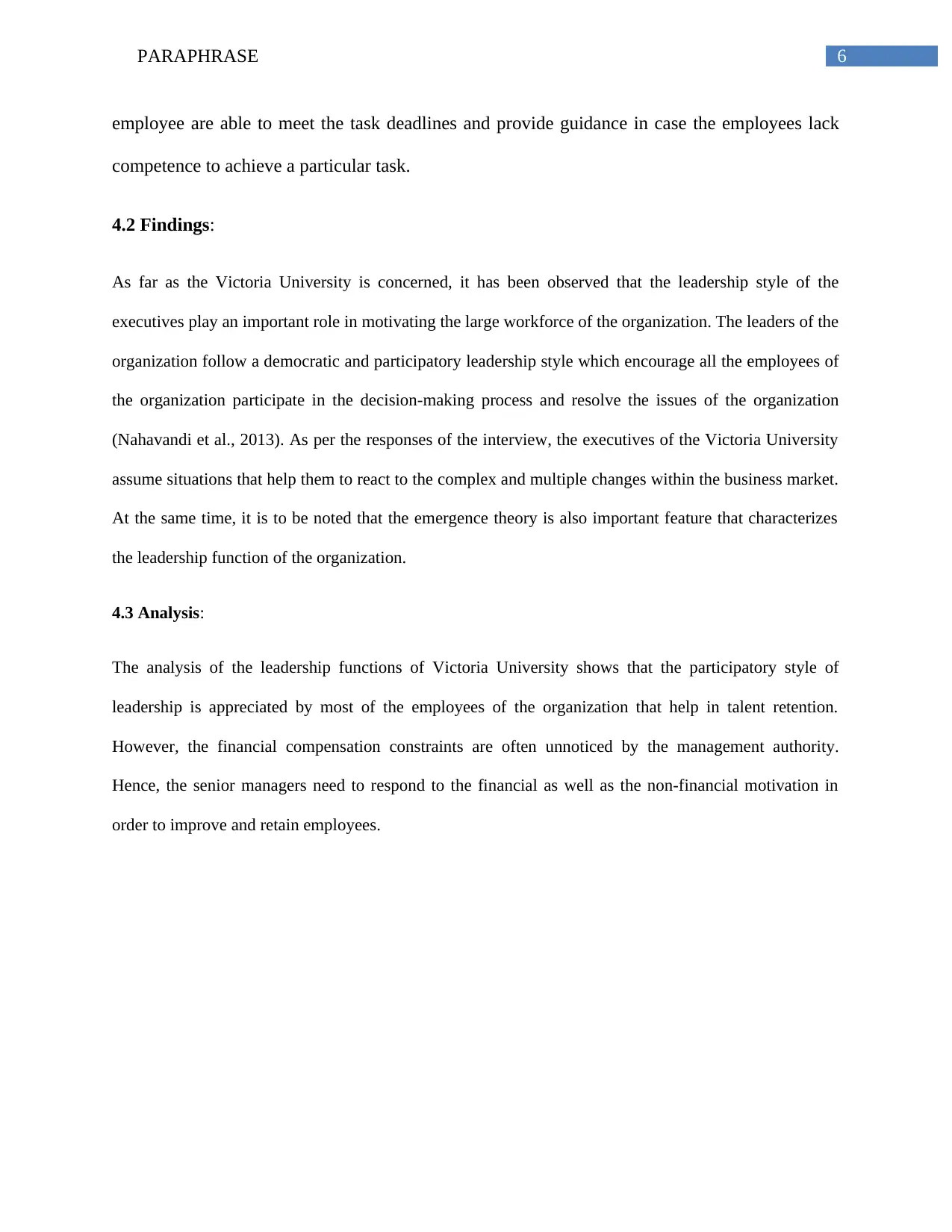
6PARAPHRASE
employee are able to meet the task deadlines and provide guidance in case the employees lack
competence to achieve a particular task.
4.2 Findings:
As far as the Victoria University is concerned, it has been observed that the leadership style of the
executives play an important role in motivating the large workforce of the organization. The leaders of the
organization follow a democratic and participatory leadership style which encourage all the employees of
the organization participate in the decision-making process and resolve the issues of the organization
(Nahavandi et al., 2013). As per the responses of the interview, the executives of the Victoria University
assume situations that help them to react to the complex and multiple changes within the business market.
At the same time, it is to be noted that the emergence theory is also important feature that characterizes
the leadership function of the organization.
4.3 Analysis:
The analysis of the leadership functions of Victoria University shows that the participatory style of
leadership is appreciated by most of the employees of the organization that help in talent retention.
However, the financial compensation constraints are often unnoticed by the management authority.
Hence, the senior managers need to respond to the financial as well as the non-financial motivation in
order to improve and retain employees.
employee are able to meet the task deadlines and provide guidance in case the employees lack
competence to achieve a particular task.
4.2 Findings:
As far as the Victoria University is concerned, it has been observed that the leadership style of the
executives play an important role in motivating the large workforce of the organization. The leaders of the
organization follow a democratic and participatory leadership style which encourage all the employees of
the organization participate in the decision-making process and resolve the issues of the organization
(Nahavandi et al., 2013). As per the responses of the interview, the executives of the Victoria University
assume situations that help them to react to the complex and multiple changes within the business market.
At the same time, it is to be noted that the emergence theory is also important feature that characterizes
the leadership function of the organization.
4.3 Analysis:
The analysis of the leadership functions of Victoria University shows that the participatory style of
leadership is appreciated by most of the employees of the organization that help in talent retention.
However, the financial compensation constraints are often unnoticed by the management authority.
Hence, the senior managers need to respond to the financial as well as the non-financial motivation in
order to improve and retain employees.
Paraphrase This Document
Need a fresh take? Get an instant paraphrase of this document with our AI Paraphraser

7PARAPHRASE

8PARAPHRASE

9PARAPHRASE
1 out of 10
Related Documents
Your All-in-One AI-Powered Toolkit for Academic Success.
+13062052269
info@desklib.com
Available 24*7 on WhatsApp / Email
![[object Object]](/_next/static/media/star-bottom.7253800d.svg)
Unlock your academic potential
© 2024 | Zucol Services PVT LTD | All rights reserved.





